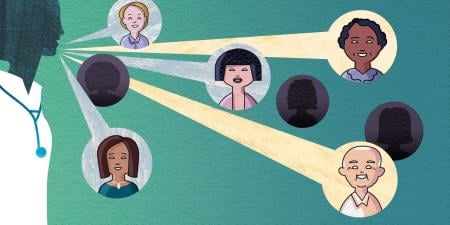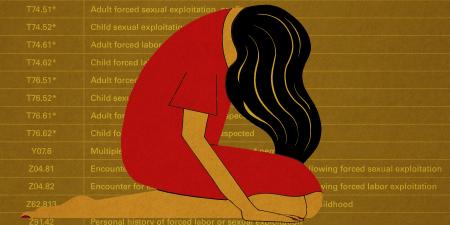Abstract
This first-person narrative describes some of the barriers to caring well for patients at the intersection of human trafficking and substance use disorder. I canvass some of the ethical considerations regarding these patients’ autonomy and call for establishing and using evidence-based practice to manage these complex scenarios.
One Trafficked Patient
Her phone sat in a plastic evidence bag on the counter where we stand to do our clinical notes. It had been dropped off by an area drug detective for me to return to the young woman in the room across the hall from me. She had been brought to the emergency department after she had been offered help by the same detective during a sting to arrest pimps, people who traffic women in the sex trade for profit and drugs. This woman was 23. She told the detective that she had been living out of a car and motels for 2 weeks, travelling between New York and Maine, kept under control by her traffickers with threats of violence and drugs. She was being trafficked with another woman and would have sometimes upwards of 10 “dates” a day. She saw none of the money; it was all handed over in exchange for transportation, boarding, and drugs. She had a 5-year history of opioid abuse, starting with oxycodone supplied by a boyfriend and now intravenous fentanyl, cocaine, and benzodiazepines. She has a daughter who lives with her grandmother and very little else—no friends, no other family, no job, and no place to live.
The phone buzzed on the counter every 30 to 45 seconds. “You Raw Dog?” “Can we do fitty? I’ll bring party favors.” “How much for a double?” These were messages from men, responding to an ad, looking for sex. It was endless. The area codes ranged from Maine, to New Hampshire, to Rhode Island, to New York. The constancy of these messages was shocking. Even more distressing was the display underlying the phone’s cracked glass of this patient holding her daughter, no more than 2 years old, wearing a pink dress and matching ribbons in her hair, a “Happy Birthday” banner in the background.
I went in to examine Alyssa (not her real name). She was rail thin, her eyes sunken, her hair knotted and in disarray. She had a peripherally inserted central catheter (PICC) in her right forearm, placed a week ago at an outside hospital. She was being treated for osteomyelitis but had left against medical advice and had been off antibiotics since then. She said the PICC line hurt and admitted she had been using it to inject drugs. The bandage around the site was tattered and dirty, and I had asked the nurse to clean the site and change the bandage. I ordered a replacement line, although admittedly with some reluctance wondering whether she would stay for treatment this time. We drew labs, treated her for gonorrhea and chlamydia and offered an HIV test, which she refused. After a long discussion, she agreed to stay to get medical treatment for her infection in the hope for transfer to a facility that could manage her medical issues and her mental health issues, which included depression, anxiety, and bipolar disorder. This was a tall order as few beds—called dual diagnosis beds—exist and the ones that do are rarely empty. The emergency department (ED) social worker and I had a plan, though, and it was put into action. Alyssa left the ED to go to interventional radiology for a new PICC line and, from there, to her bed on the medical floor for management of her medical issues before we could address her mental health concerns.
I went to check on her the following day and she was gone. A “man” had come to visit and then she was gone. We were certain that the man was her pimp; he came to get his property. Any time she spent in a hospital bed was money lost. He couldn’t have that.
Reflections on Caring for a “Captive” Patient
I think about this case a lot. We aren’t particularly well equipped as a profession to deal with these cases, which was apparent from the start of this case. No one was really all that comfortable in addressing that this person was and remains a victim of human trafficking, a modern-day slave, and that she is being sold online, subjugated through violence and drugs. We offered comfort and treatment, but could we have done more to protect her? Can she make autonomous decisions? Does she possess this value we all hold so dearly when she is enslaved, not just to drugs but to another person through coercion and violence? When offered the choice of treatment or returning to the street, can she make this decision in an informed way? There was very little we had to offer except encouragement, comfort, and empathy. There were no legal grounds to hold her against her will or to deny her decision to leave, despite her circumstances.
Her care might also have been impacted by defining her as a person who is being trafficked. Saying someone is being trafficked labels him or her less as a person and more as a commodity. There is a loss of identity in that label, a loss of being seen as a patient and, more so, as a person. This is a label that carries significant stigma and can have an impact on how a patient is viewed and treated. Unknowingly, nurses, physicians, and other health care practitioners might avoid this patient, not because they lack compassion but because they are simply ill equipped to deal with a patient who is being controlled, manipulated, and restrained. I struggled with this as well. Clinician-patient interactions can be uncomfortable when clinicians are dealing with someone they struggle to understand and who might even seem impossible to understand. I worried about how this patient would be viewed and would be treated. Terms such as prostitute or sex worker are often used for these persons, not likely with any wrongful intent but because they are the terms we know. Did we unknowingly harm this patient by labeling her as trafficked?
There was another issue that caused me some apprehension. What did I learn from this patient? Has my experience made me better equipped for the next time we have a patient in a similar situation? Will I do better by the patient, protect him or her in a way that I feel we failed with Alyssa? Can we use the label trafficked as an excuse, a way to alleviate responsibility since it is widely understood that trafficked patients are often trapped, have lost autonomy, and are very difficult to get into treatment? Does it offer the convenience of an excuse to say, “Well, we tried our best”?
The Intersection of Human Trafficking and Health Care
Although human trafficking is happening all across the United States, providers and clinicians are mostly unequipped to address it. While some professional organizations have pushed for educational efforts, there are still deficiencies in the use of evidence-based screening tools as well as clinician knowledge on the topic.1,2 There is a National Human Trafficking Hotline and law enforcement can be an excellent resource as well.3 State mandated reporting in the case of a minor being trafficked provides a mechanism by which clinicians can try to help children they suspect are being trafficked, and the Health Insurance Portability and Accountability Act (HIPAA) does allow release of some patient information to law enforcement if a patient is deemed at significant risk or in imminent danger.4
There is very little in the way of an evidence-based approach for how best to address patient autonomy and barriers to treatment in in this patient population. In the setting of human trafficking, the mind and the person are enslaved. It is difficult to say whether that person still possesses the ability to make autonomous decisions.5 While many states have mandated treatment for acute psychiatric issues and some for substance abuse,6,7 there are no states that have mandated treatment for adult victims of human trafficking.8 If a patient who is—or who is suspected of being—involved in human trafficking wants to leave, to sign out against medical advice, she or he is typically free to do so.
An Opportunity for Improvement
The phone number Alyssa had provided us was a dead end—an out-of-order phone. Her contact phone number yielded similar results. The detective who brought her in lost track of her, too. This is the reality of these cases. I think of that child, that “Happy Birthday” banner, and wonder if that banner will be the only one Alyssa ever hangs, if she will see her child again, and just how powerful addiction can be to take her away from that.
I think about how we need to be better prepared as a profession to deal with victims of human trafficking and how we need to do anything and everything we can to protect them. As health care practitioners, we need to think about the ethical implications of how we manage patients who are victims of trafficking and how we can ethically protect them. These efforts should start with clinicians learning how to identify potential victims, how to provide trauma-informed care, and how to access resources to provide the best possible care to these patients. There are several resources, including the HEAL toolkit,9 which can help clinicians and hospitals develop protocols for responding to potential trafficking victims from an interdisciplinary perspective.
In addition, we as health care practitioners need to stimulate public discussions so that legislators are aware and consider special, ethically balanced protections for trafficked persons. Either a component of or separate from the opioid epidemic, human trafficking is a major public health issue that we need to be better equipped to manage.
I fear I know when the cycle of trafficking and substance abuse will stop Alyssa. I can only hope that “Happy Birthday” banner serves as a beacon for Alyssa to find her way home.
References
- Beck ME, Lineer MM, Melzer-Lange M, Simpson P, Nugent M, Rabbitt A. Medical providers’ understanding of sex trafficking and their experiences with at-risk patients. Pediatrics. 2015;135(4):e895-e902.
-
Powell C, Dickins K, Stoklosa H. Training US health care professionals on human trafficking: where do we go from here? Med Educ Online. 2017;22(1):1267980. doi:10.1080/10872981.2017.1267980.
-
National Human Trafficking Hotline website. https://humantraffickinghotline.org/. Accessed September 11, 2018.
-
US Department of Health and Human Services. FAQ 520: Does HIPAA permit a provider to disclose PHI about a patient if the patient presents a serious danger to self or others? https://www.hhs.gov/hipaa/for-professionals/faq/520/does-hipaa-permit-a-health-care-provider-to-disclose-information-if-the-patient-is-a-danger/index.html. Published November 25, 2008. Accessed September 11, 208.
- Stoklosa H, MacGibbon M, Stoklosa J. Human trafficking, mental illness, and addiction: avoiding diagnostic overshadowing. AMA J Ethics. 2017;19(1):23-24.
-
Werb D, Kamarulzaman A, Meacham MC, et al. The effectiveness of compulsory drug treatment: a systematic review. Int J Drug Policy. 2016;28:1-9.
-
Lunze K, Idrisov B, Golichenko M, Kamarulzaman A. Mandatory addiction treatment for people who use drugs: global health and human rights analysis. BMJ. 2016;353:i2943. doi:10.1136/bmj.i2943.
- Atkinson HG, Curnin KJ, Hanson NC. US state laws addressing human trafficking: education of and mandatory reporting by health care providers and other professionals. J Hum Trafficking. 2016;2(2):111-138.
-
HEAL Trafficking. HEAL Trafficking and Hope for Justice’s protocol toolkit. https://healtrafficking.org/2017/06/new-heal-trafficking-and-hope-for-justices-protocol-toolkit-for-developing-a-response-to-victims-of-human-trafficking-in-health-care-settings/. Accessed September 7, 2018.



